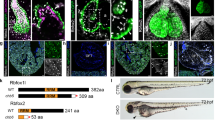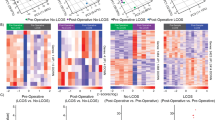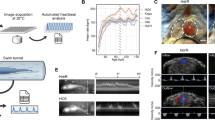Abstract
Hypoplastic left heart (HLH) occurs in at least 1 in 10 000 live births but may be more common in utero. Its causes are poorly understood but a number of affected cases are associated with chromosomal abnormalities. We set out to localize the breakpoints in a patient with sporadic HLH and a de novo translocation. Initial studies showed that the apparently simple 1q41;3q27.1 translocation was actually combined with a 4-Mb inversion, also de novo, of material within 1q41. We therefore localized all four breakpoints and found that no known transcription units were disrupted. However we present a case, based on functional considerations, synteny and position of highly conserved non-coding sequence elements, and the heterozygous Prox1+/− mouse phenotype (ventricular hypoplasia), for the involvement of dysregulation of the PROX1 gene in the aetiology of HLH in this case. Accordingly, we show that the spatial expression pattern of PROX1 in the developing human heart is consistent with a role in cardiac development. We suggest that dysregulation of PROX1 gene expression due to separation from its conserved upstream elements is likely to have caused the heart defects observed in this patient, and that PROX1 should be considered as a potential candidate gene for other cases of HLH. The relevance of another breakpoint separating the cardiac gene ESRRG from a conserved downstream element is also discussed.
Similar content being viewed by others
Log in or create a free account to read this content
Gain free access to this article, as well as selected content from this journal and more on nature.com
or
Accession codes
References
Grossfeld PD : The genetics of hypoplastic left heart syndrome. Cardiol Young 1999; 9: 627–632.
Hoffman JI, Kaplan S : The incidence of congenital heart disease. J Am Coll Cardiol 2002; 39: 1890–1900.
Simpson JM : Hypoplastic left heart syndrome. Ultrasound Obstet Gynecol 2000; 15: 271–278.
Phillips HM, Renforth GL, Spalluto C et al: Narrowing the critical region within 11q24-qter for hypoplastic left heart and identification of a candidate gene, JAM3, expressed during cardiogenesis. Genomics 2002; 79: 475–478.
Jacobsen P, Hauge M, Henningsen K, Hobolth N, Mikkelsen M, Philip J : An (11;21) translocation in four generations with chromosome 11 abnormalities in the offspring. A clinical, cytogenetical, and gene marker study. Hum Hered 1973; 23: 568–585.
Brackley KJ, Kilby MD, Wright JG et al: Outcome after prenatal diagnosis of hypoplastic left-heart syndrome: a case series. Lancet 2000; 356: 1143–1147.
Allan LD, Sharland GK, Milburn A et al: Prospective diagnosis of 1,006 consecutive cases of congenital heart disease in the fetus. J Am Coll Cardiol 1994; 23: 1452–1458.
Natowicz M, Chatten J, Clancy R et al: Genetic disorders and major extracardiac anomalies associated with the hypoplastic left heart syndrome. Pediatrics 1988; 82: 698–706.
Sletten LJ, Pierpont ME : Variation in severity of cardiac disease in Holt-Oram syndrome. Am J Med Genet 1996; 65: 128–132.
Baujat G, Le Merrer M : Ellis-van Creveld syndrome. Orphanet J Rare Dis 2007; 2: 27.
Hanauer D, Argilla M, Wallerstein R : Rubinstein-Taybi syndrome and hypoplastic left heart. Am J Med Genet 2002; 112: 109–111.
Maestri NE, Beaty TH, Boughman JA : Etiologic heterogeneity in the familial aggregation of congenital cardiovascular malformations. Am J Hum Genet 1989; 45: 556–564.
Grobman W, Pergament E : Isolated hypoplastic left heart syndrome in three siblings. Obstet Gynecol 1996; 88: 673–675.
Kojima H, Ogimi Y, Mizutani K, Nishimura Y : Hypoplastic-left-heart syndrome in siblings. Lancet 1969; 2: 701.
Hajdu J, Marton T, Toth-Pal E et al: Severe left heart developmental disorder and severe fetal arrhythmia in the same family – a coincidental association? Orv Hetil 1998; 139: 767–769.
Brownell LG, Shokeir MH : Inheritance of hypoplastic left heart syndrome (HLHS): further observations. Clin Genet 1976; 9: 245–249.
Loffredo CA, Chokkalingam A, Sill AM et al: Prevalence of congenital cardiovascular malformations among relatives of infants with hypoplastic left heart, coarctation of the aorta, and d-transposition of the great arteries. Am J Med Genet A 2004; 124A: 225–230.
Brenner JI, Berg KA, Schneider DS, Clark EB, Boughman JA : Cardiac malformations in relatives of infants with hypoplastic left-heart syndrome. Am J Dis Child 1989; 143: 1492–1494.
Gill HK, Splitt M, Sharland GK, Simpson JM : Patterns of recurrence of congenital heart disease: an analysis of 6,640 consecutive pregnancies evaluated by detailed fetal echocardiography. J Am Coll Cardiol 2003; 42: 923–929.
Male A, Davies A, Bergbaum A et al: Delineation of an estimated 6.7 MB candidate interval for an anophthalmia gene at 3q26.33-q28 and description of the syndrome associated with visible chromosome deletions of this region. Eur J Hum Genet 2002; 10: 807–812.
Iafrate AJ, Feuk L, Rivera MN et al: Detection of large-scale variation in the human genome. Nat Genet 2004; 36: 949–951.
Carter NP : Bivariate chromosome analysis using a commercial flow cytometer. Methods Mol Biol 1994; 29: 187–204.
Piper K, Brickwood S, Turnpenny LW et al: Beta cell differentiation during early human pancreas development. J Endocrinol 2004; 181: 11–23.
Hearn T, Spalluto C, Phillips VJ et al: Subcellular localization of ALMS1 supports involvement of centrosome and basal body dysfunction in the pathogenesis of obesity, insulin resistance, and type 2 diabetes. Diabetes 2005; 54: 1581–1587.
Oliver G, Sosa-Pineda B, Geisendorf S, Spana EP, Doe CQ, Gruss P : Prox 1, a prospero-related homeobox gene expressed during mouse development. Mech Dev 1993; 44: 3–16.
Tomarev SI, Sundin O, Banerjee-Basu S, Duncan MK, Yang JM, Piatigorsky J : Chicken homeobox gene Prox 1 related to Drosophila prospero is expressed in the developing lens and retina. Dev Dyn 1996; 206: 354–367.
Wigle JT, Oliver G : Prox1 function is required for the development of the murine lymphatic system. Cell 1999; 98: 769–778.
Wigle JT, Chowdhury K, Gruss P, Oliver G : Prox1 function is crucial for mouse lens-fibre elongation. Nat Genet 1999; 21: 318–322.
Tada T, Kishimoto H : Ultrastructural and histological studies on closure of the mouse ductus arteriosus. Acta Anat (Basel) 1990; 139: 326–334.
Harvey NL, Srinivasan RS, Dillard ME et al: Lymphatic vascular defects promoted by Prox1 haploinsufficiency cause adult-onset obesity. Nat Genet 2005; 37: 1072–1081.
Risebro CA, Searles RG, Melville AA et al: Prox1 maintains muscle structure and growth in the developing heart. Development 2009; 136: 495–505.
Duncan MK, Cui W, Oh DJ, Tomarev SI : Prox1 is differentially localized during lens development. Mech Dev 2002; 112: 195–198.
Lavado A, Oliver G : Prox1 expression patterns in the developing and adult murine brain. Dev Dyn 2007; 236: 518–524.
Wilting J, Buttler K, Schulte I, Papoutsi M, Schweigerer L, Manner J : The proepicardium delivers hemangioblasts but not lymphangioblasts to the developing heart. Dev Biol 2007; 305: 451–459.
Rodriguez-Niedenfuhr M, Papoutsi M, Christ B et al: Prox1 is a marker of ectodermal placodes, endodermal compartments, lymphatic endothelium and lymphangioblasts. Anat Embryol (Berl) 2001; 204: 399–406.
Wheway JM, Yau SC, Nihalani V et al: A complex deletion-inversion-deletion event results in a chimeric IL1RAPL1-dystrophin transcript and a contiguous gene deletion syndrome. J Med Genet 2003; 40: 127–131.
Koolen DA, Vissers LE, Pfundt R et al: A new chromosome 17q21.31 microdeletion syndrome associated with a common inversion polymorphism. Nat Genet 2006; 38: 999–1001.
Shaw-Smith C, Pittman AM, Willatt L et al: Microdeletion encompassing MAPT at chromosome 17q21.3 is associated with developmental delay and learning disability. Nat Genet 2006; 38: 1032–1037.
Zollino M, Lecce R, Murdolo M et al: Wolf-Hirschhorn syndrome-associated chromosome changes are not mediated by olfactory receptor gene clusters nor by inversion polymorphism on 4p16. Hum Genet 2007; 122: 423–430.
Woolfe A, Goodson M, Goode DK et al: Highly conserved non-coding sequences are associated with vertebrate development. PLoS Biol 2005; 3: e7.
Ovcharenko I, Loots GG, Nobrega MA, Hardison RC, Miller W, Stubbs L : Evolution and functional classification of vertebrate gene deserts. Genome Res 2005; 15: 137–145.
Shopland LS, Lynch CR, Peterson KA et al: Folding and organization of a contiguous chromosome region according to the gene distribution pattern in primary genomic sequence. J Cell Biol 2006; 174: 27–38.
Kleinjan DA, van Heyningen V : Long-range control of gene expression: emerging mechanisms and disruption in disease. Am J Hum Genet 2005; 76: 8–32.
Pfeifer D, Kist R, Dewar K et al: Campomelic dysplasia translocation breakpoints are scattered over 1 Mb proximal to SOX9: evidence for an extended control region. Am J Hum Genet 1999; 65: 111–124.
de Kok YJ, Vossenaar ER, Cremers CW et al: Identification of a hot spot for microdeletions in patients with X-linked deafness type 3 (DFN3) 900 kb proximal to the DFN3 gene POU3F4. Hum Mol Genet 1996; 5: 1229–1235.
Lettice LA, Horikoshi T, Heaney SJ et al: Disruption of a long-range cis-acting regulator for Shh causes preaxial polydactyly. Proc Natl Acad Sci USA 2002; 99: 7548–7553.
Ovcharenko I, Loots GG, Giardine BM et al: Mulan: multiple-sequence local alignment and visualization for studying function and evolution. Genome Res 2005; 15: 184–194.
Acknowledgements
We are indebted to the proband and his family. HKG was supported by a research fellowship from the Guy's and St Thomas' Charitable Foundation. BLN and NPC are supported by the Wellcome Trust. SRP was supported by a Health Foundation Fellowship. CS, VJK and DIW are supported by the British Heart Foundation and Little Heart Matters. RGR received funding from the British Heart Foundation and the Muscular Dystrophy Campaign. We are not aware of any conflicts of interest.
Author information
Authors and Affiliations
Corresponding author
Additional information
Supplementary Information accompanies the paper on European Journal of Human Genetics website (http://www.nature.com/ejhg)
Supplementary information
Rights and permissions
About this article
Cite this article
Gill, H., Parsons, S., Spalluto, C. et al. Separation of the PROX1 gene from upstream conserved elements in a complex inversion/translocation patient with hypoplastic left heart. Eur J Hum Genet 17, 1423–1431 (2009). https://doi.org/10.1038/ejhg.2009.91
Received:
Revised:
Accepted:
Published:
Issue date:
DOI: https://doi.org/10.1038/ejhg.2009.91



